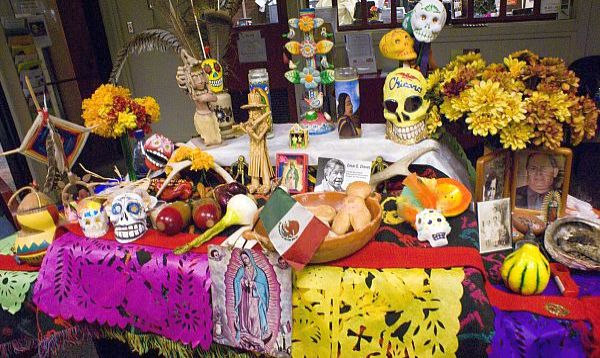Around Halloween time each year, you may notice that there's another holiday where candy and skeletons are a big part of the festivities. That would be El Día de los Muertos aka "'The Day of the Dead." Most likely you've heard of it, but if you're anything like me, you don't know all that much about it. Luckily, that's about to change that for you.
El Día de los Muertos is a Mexican holiday that falls on November 1st and 2nd, where friends and family remember and pray for their loved ones who have died. While it's a national holiday in Mexico, celebrations take place all around the world, and have become increasingly common in parts of the US with large Hispanic populations.
The holiday is celebrated in connection with the Catholic holidays "All Saints' Day," which falls on November 1st and is a day to honor all the saints, and "All Souls' Day" on November 2nd, a feast to commemorate those who have died and are now in purgatory.
Now that you have a sense of what El Día de Muertos is all about, read on to learn the 5 things that make it such a unique and interesting holiday!
It's Really an Aztec Holiday
El Día de Muertos originated 3,000 years ago with the Aztecs, who had annual ceremonies, not to mourn, but to honor the deceased and to welcome the temporary return of their spirits. When the Spanish conquistadors conquered the Aztec Empire in the early 1500's, they brought with them Catholicism, hence All Souls and All Saints Day, which were their own answers to honoring the dead. The result, the Día de Muertos we know today.
Dia de Muertos Requires an Altar of Offerings, Not Just a Candy Basket
One of the things family and friends do on this holiday is build altars - altares de muertos - to welcome the spirits of the deceased. Laid out on top of the altars are offerings, or ofrendas, for the dead, such as candles, incense, marigolds, fresh fruits, photos of the departed, and things they enjoyed while they were alive.
Edible Skulls are Offered to the Living and the Deceased
Sugar skulls, calaveras de azúcar, are kind of like the mascot of El Día de Muertos. They are a symbol of death and afterlife, and are often used to decorate altars. They are also given as gifts on this holiday, especially to kids. Besides being incredibly adorable, they're easy to make at home using a mold or simply your hands. Here is a great sugar skulls recipe with instructional videos from MexicanSugarSkull.com.
Bread of the Dead is Eaten at the Altar
No El Día de Muertos celebration is complete without bread of the dead, or pan de muerto. It's a sweet, egg-based bread usually containing the herb anise, and made during the weeks leading up to the holiday. The bread can be baked in different shapes such as skulls, bones, flowers, and animals, and is often eaten at the altar. If you want to serve some at home, here's an authentic pan de muerto recipe.
Souls Fly on the Wings of Butterflies
While fall is the season for El Día de Muertos, it's also when monarch butterflies arrive in Mexico. Legend has it that the butterflies are the souls of the deceased returning to earth.
Now, if you want to start incorporating this incredible holiday into your fall festivities you have loads of inspiration, recipes and background to make you a pro. Feliz Día de Muertos!
Original Story


